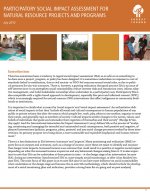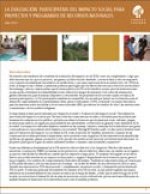Participatory Social Impact Assessment for Natural Resource Projects and Programs
By Michael Richards - Forest Trends View PublicationThere is a growing realization that good practice Social Impact Assessment (SIA) is an issue of self-interest; it can strengthen social sustainability, reduce investor risks and transaction costs, inform adaptive management, and build stakeholder ownership when undertaken in a participatory way. Participatory SIA is also compatible with a rights-based approach to development, especially free prior and informed consent (FPIC), which is increasingly required for natural resource (NR) interventions that affect indigenous or community livelihoods or institutions.
SIA can be undertaken at three points in time – at the design stage of an intervention (ex ante SIA), during an intervention (‘synchronized SIA’ or, more simply, social monitoring), or after it has finished (ex post SIA). This brief discusses ex ante SIA since SIA can have most influence on social sustainability when undertaken at the design stage and because the ex ante SIA methodology, which should include the development of a social monitoring plan and indicators, provides a strong basis for on-going and ex-post analysis.


